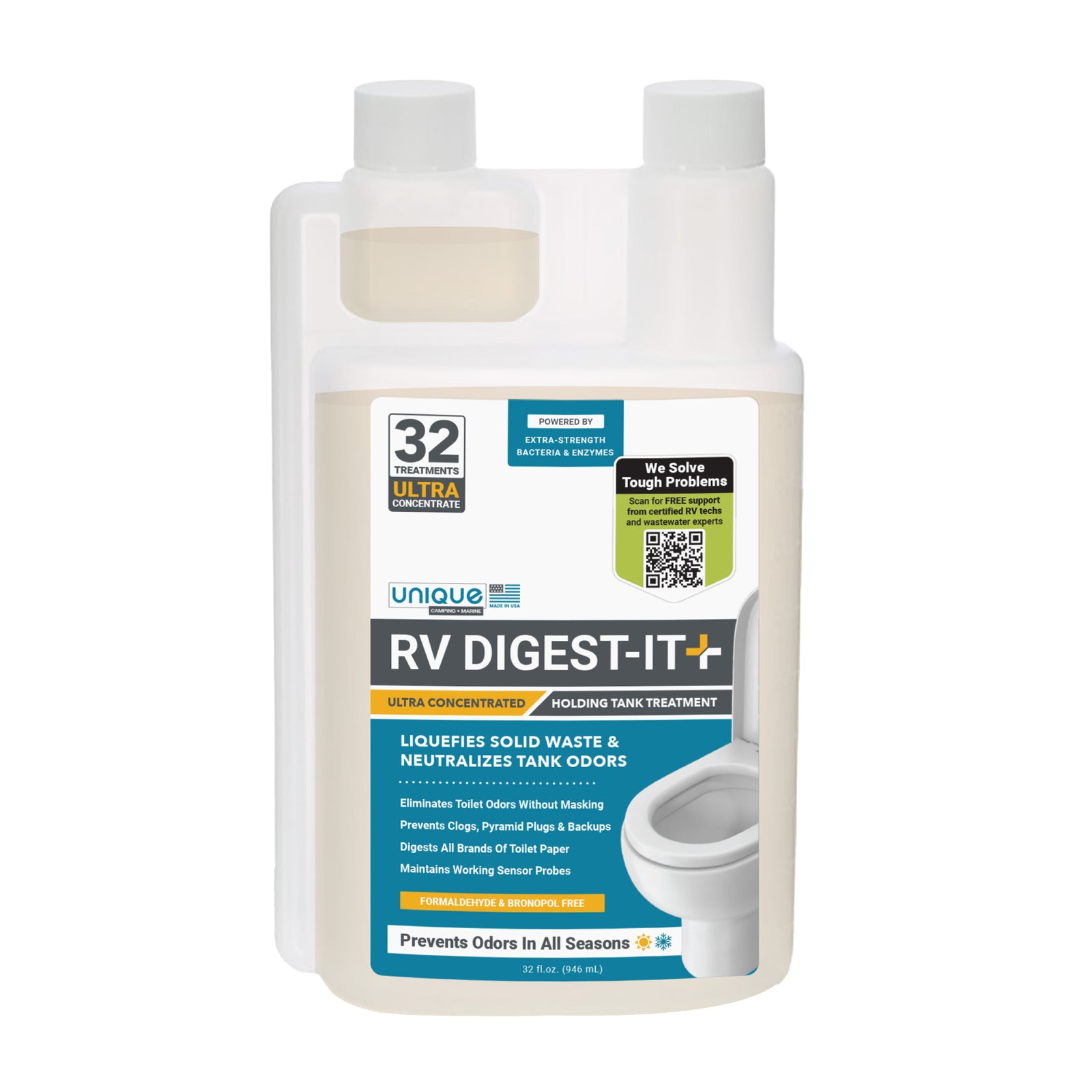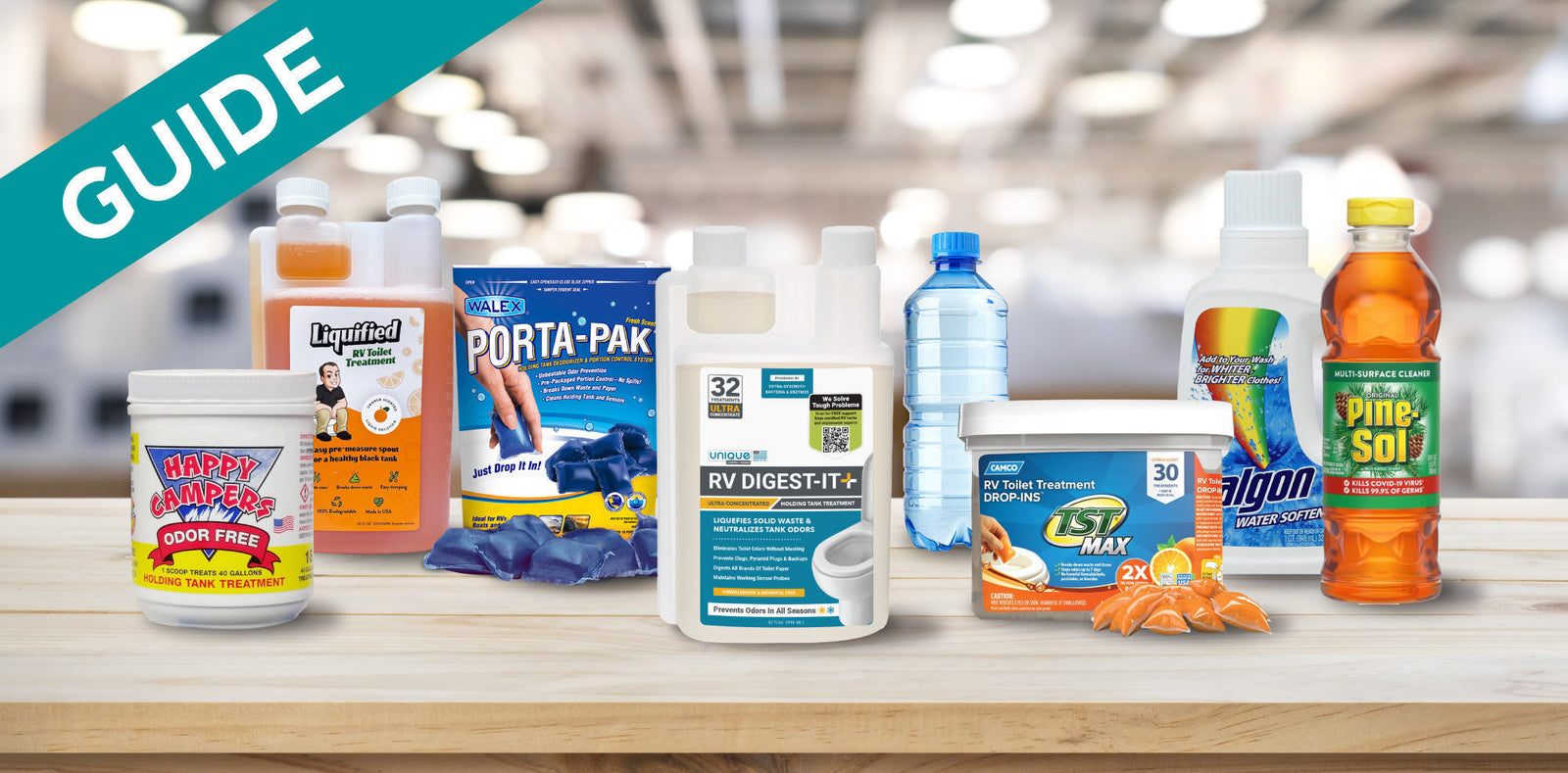
Antifreeze is a regular part of automotive maintenance in both freezing and high heat environments, but is it necessary for RVs? The short answer is, yes. Freezing temperatures can cause lingering water in the camper’s lines and fittings to freeze, expand, and eventually burst — leading to costly, and time-consuming repairs.
However, you can’t use automotive antifreeze in RVs, you need to use specially-formulated RV antifreeze that is compatible with camper plumbing systems and tank components. In this article, we’ll give you the full rundown on RV antifreeze, walking you through the basics, how to choose the right option for your needs, and how to use it safely and effectively.
If you need help dealing with frozen RV pipes and tanks, read this guide: How to Unfreeze RV Pipes and Tanks
Key Points About Using Antifreeze in RV Holding Tanks
- There are three main types of antifreeze including propylene glycol, ethanol, and ethylene glycol.
- We recommend propylene glycol RV antifreeze because it is safe, non-toxic, less corrosive, and more environmentally friendly.
- RV antifreeze should only be used to winterize your RV (preparing it for storage through winter), not as a means to prevent liquid in the holding tanks from freezing while in use (when camping in below-freezing temperatures).
- High levels of RV antifreeze can still cause harm to humans, animals, and the environment, and all types of antifreeze are flammable, so take caution.
Antifreeze Basics
Antifreeze, commonly referred to as engine coolant, is a fluid added to a vehicle’s cooling system to prevent it from freezing in cold weather and overheating in hot weather.
At the most basic level, the chemicals in antifreeze improve the temperature rating — lowering the burst rating by stopping water from freezing solid in cold temperatures, and preventing damage to vehicle components. It also raises the boiling point of the coolant, preventing it from boiling over in hot weather and causing overheating.
Commercially, both the additive (pure concentrate) and the mixture (pre-diluted solution) are called antifreeze, depending on the context and usage.
RV antifreeze is a specially formulated, pink-colored liquid (typically) that is designed to protect plumbing systems from freezing in recreational vehicles and boats.
Antifreeze typically includes one of the following chemical components:
- Propylene Glycol: Non-toxic, clear, colorless, viscous liquid that is practically odorless. As a humectant, emollient, and preservative, propylene glycol holds moisture and improves the texture and consistency of food, drugs, paints, and more.
- Ethanol: Also known as ethyl alcohol or grain alcohol, is a clear, colorless liquid that is commonly used in alcoholic beverages, as a solvent in industrial applications, and a fuel additive in gasoline.
- Ethylene Glycol: Synthetic liquid substance that absorbs water. It’s a toxic alcohol, and even though it is similar to ethanol, it is much more poisonous if consumed.
Now let’s take a closer look at the different types of antifreeze.
Types of Antifreeze: RV vs. Automotive Antifreeze
RV antifreeze can be made with several different chemicals, making each formula compatible with different uses and materials. Choosing the right formulation can help you prevent corrosion, premature wear of RV components, and disruption of RV wastewater system functionality.
Propylene Glycol RV Antifreeze
Propylene glycol is the safest, non-toxic antifreeze to use in your RV. Using propylene glycol as the primary ingredient, it is effective at lowering the freezing point of water and more environmentally friendly.
We recommend using propylene glycol camper antifreeze when winterizing your RV. It is the safest option because it is less corrosive than other options. When tested, propylene glycol antifreeze does not damage gaskets and tank components over time, whereas ethanol antifreeze does.
Ethanol RV Antifreeze
Ethanol antifreeze is a type of solution that uses ethyl alcohol as the primary ingredient. It can effectively lower the freezing point of water, and prevent damage from freezing and expansion. However, ethanol-based fluids can vaporize more easily in higher temperatures, which means it may need to be replenished more frequently in some applications.
This type of antifreeze is considered safe to use in RVs, however, it is also very effective at absorbing water, meaning that it may dry out rubber seals faster than they naturally would.
It’s important to check the condition of visible seals prior to using this type of antifreeze. If the gaskets you can see are in good condition, then it is likely that the inaccessible components are in good condition, as well. However, if you see weathered and brittle seals, they may be further compromised if you use ethanol antifreeze regularly.
Ethylene Glycol Automotive Antifreeze
Ethylene glycol antifreeze is highly toxic and not safe for RV water systems. Typically, this chemical is used for automotive antifreeze, and is not for use in recreational vehicle water lines or water systems. It is unsafe to ingest, inhale, or make contact with the skin, so anytime you opt to use this product, you should use extreme caution.
Be sure that ethylene glycol antifreeze is only used to keep the engine cool and protect it from freezing, and should never be used to keep water lines from freezing. Ethylene glycol antifreeze can also be very corrosive, and may damage plastic plumbing and holding tank components over time.
Choosing the Best RV Antifreeze
Now that you understand the different types of antifreeze, let’s review some key factors to help you find the best option for your camping needs.
1. Type of Antifreeze
In RVs, the best type of antifreeze is one that is safe, effective, and doesn’t cause damage to RV plumbing.
Comparing the three main types of antifreeze:
- Propylene glycol-based antifreeze (Best Overall): Safe, non-toxic and will not negatively impact the effectiveness of Unique products, especially after the system has been thoroughly rinsed, and water lines and tanks have been drained at the start of the camping season. It is also less corrosive, meaning it won’t cause damage to RV plumbing and components.
- Ethanol-based antifreeze (Safe Alternative): Safe to use in RVs, but not preferred because it may cause unnecessary wear and tear on RV components and rubber seals.
- Ethylene glycol-based antifreeze (Not Recommended): Should never be used in RV holding tanks because it is highly toxic and very corrosive.
2. Temperature Rating
When choosing a specific RV antifreeze, it is important to review the product’s temperature rating. Most non-toxic antifreeze is rated for burst protection to -50°F. This means that no ice crystals will form until the temperature drops below -26°F [-32°C], and ice will not be able to expand and cause damage (burst) until reaching temperatures lower than -50°F [-46°C].
For most cold weather climates, the -50°F rating is strong enough, however, areas with extremely low temperatures may require antifreeze formulas rated for -100 °F.
3. Concentration
Before buying RV-safe antifreeze, it’s crucial to choose a concentration that is strong enough for freeze and burst protection, and does not require dilution. RV antifreeze should only be used at full strength, and should not be manually diluted in any way. Full-strength antifreeze can still freeze solid, but prevents expansion, which is what keeps RV pipes and fittings from breaking.
4. Compatibility & Additives
There’s more to RV antifreeze than the primary ingredient, and many formulations include supportive additives to further protect your RV by increasing lubrication (reducing friction and wear) and preventing corrosion and rust (protecting vehicle components from degradation).
Common antifreeze rust and corrosion inhibitors and lubrication additives include:
- Silicates
- Phosphates
- Borates
- Nitrites
- Sodium Benzoate
- Organic Acid Technology (OAT)
Before deciding on an RV antifreeze, refer to your RV manual to ensure the ingredients are compatible with your camper. Certain additives are only designed for specific metals, materials, or vehicle makes and models, and may not be effective, or may even cause harm, if they aren’t compatible with your system.
5. Safety
When using antifreeze in your camper, it’s important to keep safety in mind. For best results, choose an RV-specific, non-toxic, propylene glycol antifreeze. This type of antifreeze is the least toxic to humans and the environment, making it safer to use in an RV’s water supply system and p-traps.
Key safety tips for using antifreeze in RVs:
- Always Use RV-Specific Antifreeze: Automotive antifreeze can damage plumbing components.
- Handle with Care: Antifreeze can stain clothing or irritate the skin, so take caution to avoid contact.
- Store Safely: Store away from ignition sources (antifreeze is flammable), in its original container, and out of reach of children and pets.
- Follow RV Manual: Follow the owner’s manual for specific guidelines about antifreeze use in your camper.
How to Use Antifreeze in RV Systems
Let’s take a closer look at how to use antifreeze in your RV, and help guide you through the entire process.
Winterizing RVs with Antifreeze
Winterizing an RV is the process of preparing your camper for storage in freezing temperatures, and can prevent frozen pipes and damage to the plumbing system and components. This involves draining all of the water from the tanks and lines, and flushing antifreeze through the system. Winterizing your RV ensures that the lines will not freeze or burst.
For full instructions about how to prepare your RV for winter storage or get it road-ready after the winter season, refer to our helpful guides:
Using RV Antifreeze While Camping
While many campers avoid taking trips in below-freezing conditions, some full-time RVers have to safely navigate through winter weather.
Using RV antifreeze in your black and gray tanks can only reduce the risk of freezing if the antifreeze is undiluted. We do not recommend using antifreeze as a way to prevent freezing while using, or living, in your RV. If you are using the water systems in your RV when temperatures drop below freezing, using tank heaters, heat tape for your water lines, RV skirting, and added insulation are safer and more reliable ways to prevent freezing while winter camping.
Important Note: For safety reasons, we do not recommend using RV antifreeze in your freshwater tank while in use. If your freshwater tank is exposed to below-freezing temperatures, the best route is to install a heating blanket.
For more information about protecting your RV tanks and plumbing in cold weather, read our guide: How to Keep Your RV Holding Tanks from Freezing
RV Antifreeze Disposal & Alternatives
RV antifreeze can be composed of several different chemicals, each with their own levels of hazardousness and toxicity. Responsible disposal of each type of RV antifreeze is critical to prevent harm to humans, animals, and the environment. The EPA does not currently offer regulations on the disposal of antifreeze, however, we have some best practices to guide you.
Proper Disposal of Propylene Glycol and Ethanol RV Antifreeze
Propylene glycol and ethanol RV antifreeze should be collected after de-winterizing the RV, and should be recycled rather than disposed of at dump stations or down your home cleanout port. Often, these dump stations feed into septic systems, and antifreeze can disrupt their functionality.
Safe places to recycle RV antifreeze include auto shops, service centers, and through local government services. If recycling services aren’t available in your area, contact the local hazardous waste facility for instructions about safe disposal.
Important Note: No type of RV antifreeze is safe to be dumped on the ground, as even the lower toxicity options can cause environmental damage and water contamination.
Safe Disposal of Ethylene Glycol Antifreeze
Ethylene glycol is considered a hazardous air pollutant under the Clean Air Act, and is known for being highly toxic. This type of antifreeze should never be used in an RV holding tank, and should never be dumped directly down drains or into the environment, as it poses serious health and safety risks.
Instead, used ethylene glycol RV antifreeze should only be disposed of at designated facilities or recycled through specialized services.
Locations that accept antifreeze for disposal or recycling:
- Automotive Repair Shops
- Recycling Centers
- Household Hazardous Waste (HHW) Facilities
- Municipal Waste Disposal Services
- Hazardous Waste Management Firms
Recycling RV Antifreeze
Recycling is the preferred method for handling antifreeze, as it is the most environmentally-friendly option. RV antifreeze recycling can be handled at onsite recycling centers, through mobile recycling services, or at offsite recycling facilities.
Recycling RV antifreeze is a two-step process that includes:
- Removing Contaminants: Through filtration, distillation, reverse osmosis, or ion exchange.
- Restoring Antifreeze Properties: Additives contain chemicals that raise and stabilize pH, inhibit rust and corrosion, reduce water scaling, and more.
RV Antifreeze Storage & Shelf Life
RV antifreeze can last for many years when sealed and stored properly. Exposure to air, heat, and sunlight can degrade antifreeze, so proper storage is crucial to maintain its effectiveness. Once opened, the shelf life of antifreeze decreases significantly to anywhere between 2 and 5 years depending on the chemicals used and the amount of exposure to oxygen, heat, and light.
Store RV antifreeze in dry, cool, and dark conditions in the original packaging for best results.
Check the quality of your RV antifreeze with these easy techniques:
- Visual Inspection: Look for discoloration or cloudiness in the liquid, or if there are particles or sludge at the bottom, which may indicate the antifreeze has degraded.
- Shake Test: Shake the bottle, if bubbles appear, the antifreeze may have expired.
- Smell Check: When you open the antifreeze bottle, if there is a sharp, sour smell, it could mean that your antifreeze has gone bad.
- Age Consideration: If the antifreeze is over 5 years old, it’s wise to replace it even if it looks fine.
Safety & Toxicity Concerns of RV Antifreeze
RV antifreeze is made of chemicals, all of which pose safety and toxicity concerns for humans, animals, and the environment. Camper-specific antifreeze is designed to be a safer alternative to automotive antifreeze, and is safe when used as directed.
Propylene glycol-based RV antifreeze is generally considered the safest. It is non-toxic, and is labeled as GRAS (Generally Regarded as Safe) by the EPA for use in food, cosmetics, and medications. While safer than other options, you should still avoid ingestion and skin contact, and follow manufacturer’s instructions for winterizing your RV to prevent unnecessary contamination.
Ethylene glycol-based antifreeze, the primary ingredient in automotive antifreeze, is highly toxic, and can cause serious health and safety risks — never use this type of antifreeze in your RV’s freshwater system.
Important Note: All forms of RV antifreeze can be harmful to the environment, so never dump directly onto the ground. Additionally, all antifreeze is flammable, so store away from ignition sources and handle with caution.
FAQs: RV Antifreeze
While we’ve run this topic through every line, we know you may still have questions about RV antifreeze. Let’s cover some of the most frequently asked questions so we can seal this up like an RV in winter storage.
1. What is RV Antifreeze?
RV antifreeze is specially formulated to prevent plumbing lines and fittings from freezing in recreational vehicles and boats. Automotive antifreeze should not be used in the fresh water systems of RVs or boats, and RV antifreeze should not be used in cars or trucks.
2. Is RV Antifreeze Toxic?
It depends. Propylene-glycol and ethanol-based RV antifreeze is generally considered safe for use, but ethylene glycol-based antifreeze (automotive antifreeze) is highly toxic, corrosive, and not recommended for use in RVs.
3. What is the Best RV Antifreeze?
The best RV antifreeze is propylene glycol antifreeze because it is non-toxic, compatible with Unique products, less corrosive, and more environmentally friendly.
4. Can I Use RV Antifreeze in My Holding Tanks?
RV antifreeze is intended to be used at full strength, and should not be used to prevent the holding tanks from freezing while using the water systems in your RV. If you are using or living in your RV when temperatures drop below freezing, other methods should be used to prevent holding tanks from freezing, including tank heaters, heat tape for your water lines, RV skirting, and added insulation.
5. Can I Put RV Antifreeze in My Freshwater Tank?
When winterizing your RV, we do not recommend putting antifreeze in your freshwater holding tank. RV antifreeze is typically added to the system at the entrance to the water pump (down stream of the freshwater holding tank). Instead, we recommend draining the freshwater tank before putting the RV into winter storage.
6. Why is RV Antifreeze Pink?
RV antifreeze is usually pink to help distinguish it from automotive antifreeze (which is usually green). The color is a visual marker, to help prevent incorrect usage and to encourage proper disposal.
7. How Much RV Antifreeze Do I Need?
For most RVs, expect to use about 2 to 3 gallons of RV antifreeze. However, this amount can vary depending on the size and layout of your RV.
8. How Do I Put RV Antifreeze in My RV?
This process involves draining the water system, bypassing the water heater, and then using a pump (RV’s water pump or bypass kit) to circulate antifreeze through all the lines and fixtures to prevent freezing.
9. How Do I Dispose of RV Antifreeze?
Propylene glycol and ethanol RV antifreeze should be properly collected and recycled, as that is the safest and most environmentally-friendly option. Ethylene glycol antifreeze is highly toxic, and can only be disposed of and recycled at special facilities. No RV antifreeze is safe to dump directly into the ground.
10. Does RV Antifreeze Go Bad?
Yes, RV antifreeze can eventually degrade and go bad. Most RV antifreeze can last many years if sealed and stored properly (in dry, cool, and dark conditions in the original packaging). However, once opened, antifreeze will start to degrade over time. Antifreeze that is over 5 years old, is discolored or murky, includes visible sediment on the bottom, has a strong, sour smell, or bubbles when shaken has likely gone bad and should be replaced.

Prevent Common Problems In Your Tanks!
From misreading sensors, preventing clogs, or eliminating odors, we've got you covered no matter how you camp! All our best holding tank tips and trick information plus more can be found conveniently in one place when you download our FREE Unique Method Field Guide PDF. Achieve holding tank bliss today!
Get The Free Download Get The Free Download



